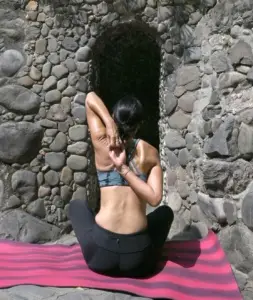
The GoInwards Pelvic Floor Dysfunction (PFD) Program addresses the significant health challenges faced by individuals suffering from conditions such as urinary incontinence, pelvic organ prolapse, and pelvic pain, often attributed to aging, childbirth, and surgeries. This integrated program combines yoga, breathwork, meditation, and mindfulness to holistically manage both the physical symptoms and psychological impacts of PFDs. Led by experienced instructors, the program aims to strengthen pelvic floor muscles, enhance flexibility, reduce pain, and improve overall well-being through evidence-based therapeutic practices. By promoting community support and continuous evaluation, the program strives to empower participants in achieving long-term health improvements and reducing dependency on traditional medical interventions.
Statement of Need
Pelvic floor dysfunctions (PFDs) represent a significant and often under-addressed healthcare challenge affecting individuals across diverse demographics, including women post-childbirth, aging populations, and individuals recovering from pelvic surgeries or trauma. These conditions encompass a range of disorders such as pelvic pain syndromes, urinary and fecal incontinence, pelvic organ prolapse, and sexual dysfunction, all of which severely impact quality of life and emotional well-being.
Current treatment approaches primarily focus on symptomatic relief through medication, physical therapy, or surgical interventions. While effective to varying degrees, these treatments often overlook the holistic needs of patients, particularly in addressing the emotional and psychological aspects of chronic pelvic pain and dysfunction. Patients frequently report feelings of isolation, frustration, and diminished self-esteem due to the chronic nature of their conditions, further exacerbating their physical symptoms.
Therapeutic practices such as mindful-based movements, breathing exercises, and meditation offer promising adjunctive therapies that can address these gaps in traditional treatment modalities. These practices promote self-awareness, emotional regulation, and physical relaxation, which are essential components for managing chronic pain, reducing stress-induced exacerbations, and improving overall pelvic health outcomes. By integrating mindfulness into treatment plans, healthcare providers can empower patients with practical tools for pain management, stress reduction, and enhanced pelvic muscle function, thereby fostering a more comprehensive approach to PFD management.
Moreover, there is a growing body of evidence supporting the effectiveness of mindful-based therapeutic interventions in improving symptoms associated with PFDs. Studies indicate that mindful practices can reduce pain perception, enhance pelvic muscle coordination, and mitigate psychological distress commonly experienced by patients. However, access to structured mindfulness programs tailored specifically for pelvic health remains limited in many healthcare settings.
Given these considerations, there is a compelling need to develop and implement a structured therapeutic program based on mindful movement, breathing, and meditation practices for PFDs. This program aims not only to alleviate physical symptoms but also to address the emotional and psychological impacts of these conditions, promoting holistic well-being and improving overall quality of life for affected individuals.
Theory of Change
This Theory of Change logic model serves as a foundational framework for understanding how interventions lead to desired outcomes. In the context of implementing a therapeutic mindfulness-based program for pelvic floor dysfunctions (PFDs), the Theory of Change outlines the pathways through which activities and inputs contribute to achieving positive impacts on patient health and well-being.
Key Components
Proposed Program
Overview
The mindful movement, breathing, and meditation program for pelvic floor dysfunctions integrates evidence-based mindfulness practices into comprehensive treatment plans. Designed to address the multifaceted nature of pelvic floor disorders, the program aims to empower patients with skills for symptom management, emotional well-being, and overall pelvic health improvement.
Program Components
Implementation Plan
The mindful movement, breathing, and meditation program for pelvic floor dysfunctions represents a progressive approach to enhancing patient care through integrative therapies. By combining physical exercises, breathing techniques, meditation practices, and individualized consultations, the program aims to address the complex needs of patients with pelvic floor disorders comprehensively. This holistic framework not only supports symptom management and pelvic muscle rehabilitation but also promotes emotional well-being, stress reduction, and overall quality of life improvements. Through structured implementation and ongoing evaluation, the program seeks to empower patients with effective tools for long-term pelvic health and holistic wellness.
Program Management
Leadership
Monitoring and Evaluation
Partnership Table
| Partner | Role and Contribution | Collaboration Details |
| Healthcare Providers | Program facilitators | Lead workshops, conduct individual consultations, and provide medical oversight for patient assessments and treatment planning. |
| Mindfulness Instructors | Mindful movement and meditation facilitation | Deliver specialized sessions on yoga, breathing exercises, and meditation techniques tailored to pelvic floor health. |
| Clinical Facilities | Program venue | Provide accessible and well-equipped spaces for group classes, individual consultations, and mindfulness sessions. |
| Holistic Health Practitioners | Integrative health counseling | Offer guidance on nutrition, stress management, and complementary therapies to support overall well-being and enhance treatment outcomes. |
| Patient Advocacy Groups | Community outreach and patient support | Advocate for program accessibility, share patient perspectives, and assist in disseminating program information to diverse populations. |
| Professional Associations | Training and accreditation | Support standardized training programs for healthcare providers and mindfulness instructors to ensure consistent delivery of program protocols. |
| Research Institutions | Evidence-based research and program evaluation | Collaborate on clinical studies, collect data on program outcomes, and contribute to advancing knowledge in integrative therapies for pelvic floor dysfunctions. |
| Technology Partners | Digital platforms and educational resources | Develop digital tools, such as mobile apps and online resources, to enhance patient engagement, provide educational content, and monitor progress remotely. |
| Community Organizations | Outreach and program integration | Partner in community outreach initiatives, facilitate program integration into local healthcare networks, and promote awareness of pelvic floor health and mindfulness practices. |
Medical Benefits
The mindful movement, breathing, and meditation program for PFD represents an innovative approach to enhancing patient care through evidence-based mindfulness interventions. By integrating these practices into treatment protocols, we aim to empower patients to manage symptoms effectively, improve pelvic health outcomes, and enhance overall quality of life. This proposal outlines a comprehensive strategy to implement mindfulness practices, fostering collaboration among healthcare providers, mindfulness instructors, and patients for optimal health and well-being.
In summary, integrating mindful movement, breathing exercises, and meditation into treatment plans for pelvic floor dysfunctions offers comprehensive benefits that address physical symptoms, emotional well-being, hormonal regulation, and psychosocial support. These practices empower patients with effective tools for pain management, muscle rehabilitation, stress reduction, and overall improvement in quality of life. This holistic approach aligns with patient-centered care principles, enhancing therapeutic outcomes and promoting long-term health and wellness.
Sample Lesson Plan
Herein is a program tailored for pelvic floor dysfunctions, focusing on physical, emotional, and mental benefits, as well as the muscles engaged and body systems affected:
| Practice | Description | Medical Benefits | Physical Benefits | Emotional Benefits | Mental Benefits | Muscles Engaged | Body Systems Affected |
| Pelvic Tilts | Flatten the lower back against the floor by tilting the pelvis upward and then releasing back to neutral. | Strengthens pelvic floor muscles, improves core stability. | Strengthens lower back and core, enhances pelvic floor engagement. | Reduces feelings of discomfort in the pelvic region. | Increases body awareness and control over pelvic muscles. | Abdominals, pelvic floor muscles | Musculoskeletal system, pelvic region |
| Bridge Pose (Setu Bandhasana) | Lift the hips toward the ceiling, engaging the pelvic floor and glutes, then lower. | Strengthens pelvic floor and glutes, improves lower back support. | Strengthens glutes, hamstrings, and lower back, improves pelvic alignment. | Boosts confidence by improving physical strength. | Enhances focus and mindfulness through controlled movement. | Glutes, hamstrings, lower back, pelvic floor muscles | Musculoskeletal system, pelvic region |
| Child’s Pose (Balasana) | Kneel on the floor, sit back on your heels, and fold forward, extending arms in front. | Relieves pelvic tension, promotes relaxation. | Stretches lower back and hips, relaxes pelvic area. | Provides a calming effect and reduces stress. | Promotes mental relaxation and helps in releasing stress. | Lower back, hips, thighs, pelvic floor muscles | Musculoskeletal system, nervous system |
| Cat-Cow Pose (Marjaryasana-Bitilasana) | Alternate between arching the back (Cow) and rounding it (Cat). Engage the core and pelvic floor during movements. | Improves spinal flexibility, strengthens pelvic floor. | Enhances spinal flexibility and core stability. | Relieves stress through gentle, rhythmic movement. | Improves mental clarity and concentration. | Core muscles, back muscles, pelvic floor muscles | Musculoskeletal system, digestive system |
| Kegel Exercises | Contract and lift the pelvic floor muscles as if stopping the flow of urine, then release. | Directly strengthens pelvic floor muscles. | Enhances pelvic floor muscle strength and endurance. | Increases sense of control and well-being. | Improves focus and awareness of pelvic floor engagement. | Pelvic floor muscles | Musculoskeletal system, pelvic region |
| Legs Up the Wall (Viparita Karani) | Lie on your back with legs extended up a wall, using a bolster under your hips. | Reduces pelvic congestion, promotes relaxation. | Relieves leg and lower back tension, improves circulation. | Promotes emotional calmness and reduces anxiety. | Enhances mental relaxation and aids in stress reduction. | Hamstrings, lower back, pelvic floor muscles | Circulatory system, lymphatic system |
| Diaphragmatic Breathing | Breathe deeply into the diaphragm, allowing the abdomen to rise and fall. | Enhances relaxation, reduces pelvic floor tension. | Promotes relaxation and reduces tension in the body. | Alleviates stress and promotes a calm emotional state. | Improves mental focus and emotional stability. | Diaphragm, abdominal muscles | Respiratory system, nervous system |
| Alternate Nostril Breathing (Nadi Shodhana) | Close one nostril, inhale through the other, switch nostrils, and exhale. Alternate. | Balances nervous system, reduces stress. | Improves breathing patterns, enhances relaxation. | Reduces anxiety and promotes emotional balance. | Enhances mental clarity, focus, and emotional equilibrium. | Diaphragm, intercostal muscles | Respiratory system, nervous system |
| Body Scan Meditation | Focus on each part of the body, starting from the toes and moving upwards, observing sensations without judgment. | Enhances body awareness, reduces tension in pelvic area. | Promotes overall physical relaxation and stress relief. | Increases emotional awareness and reduces anxiety. | Improves mindfulness and self-awareness. | Entire body | Nervous system, endocrine system |
| Loving-Kindness Meditation (Metta) | Silently repeat phrases like “May I be at ease,” extending these wishes to others. | Fosters positive emotions and reduces stress. | Promotes relaxation and positive emotional states. | Enhances feelings of compassion and reduces negative emotions. | Improves emotional resilience and positivity. | Entire body | Nervous system, cardiovascular system |
Program Structure
This program is designed to address pelvic floor dysfunctions through targeted physical exercises, breathing techniques, and meditative practices, aiming to improve overall well-being and pelvic health.

GoInwards is an IRS 501(c)(3) Non-Governmental Organization (NGO), chartered to advance wellness through integrative health related awareness, prevention, intervention, and resilience-based educational programs.
FEIN 90-0609802